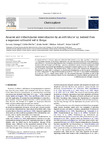Atrazine and terbuthylazine mineralization by an Arthrobacter sp. isolated from a sugarcane-cultivated soil in Kenya
| dc.contributor.author | Getenga, Zachary | |
| dc.contributor.author | Dörfler, Ulrike | |
| dc.contributor.author | Iwobi, Azuka | |
| dc.contributor.author | Schmid, Michael | |
| dc.contributor.author | Schroll, Reiner | |
| dc.date.accessioned | 2019-03-28T12:34:38Z | |
| dc.date.available | 2019-03-28T12:34:38Z | |
| dc.date.issued | 2009 | |
| dc.identifier.uri | http://ir.mksu.ac.ke/handle/123456780/4166 | |
| dc.description.abstract | A tropical soil from a Kenyan sugarcane-cultivated field showed a very high capability to mineralize 14C-ring-labeled atrazine. In laboratory experiments this soil mineralized about 90% of the applied atrazinewithin98 d.Theatrazine-degradingmicrobialcommunitywasenrichedinliquidculturescontaining atrazine as the sole N source and 100 mg L 1 glucose as additional C source. From the enrichment culture a bacterial strain was isolated and identified by comparative sequence analysis of the 16S-rDNA as member of the genus Arthrobacter. The enriched mixed culture as well as the isolated strain, designated as Arthrobacter sp. strain GZK-1, could grow on atrazine and terbuthylazine as sole N-sources; Arthrobacter sp. GZK-1 mineralized 14C-ring-labeled atrazine up to 88% to 14CO2 and 14C-ring-labeled terbuthylazine up to 65% to 14CO2 in a liquid culture within 14 d. The enriched microbial consortium as well as the isolated strain could be a potential solution for the remediation of s-triazine polluted agricultural soils. | en_US |
| dc.language.iso | en_US | en_US |
| dc.publisher | Chemosphere | en_US |
| dc.subject | Atrazine | en_US |
| dc.subject | Terbuthylazine | en_US |
| dc.subject | Mineralization | en_US |
| dc.subject | Arthrobacter | en_US |
| dc.subject | Tropical soil | en_US |
| dc.title | Atrazine and terbuthylazine mineralization by an Arthrobacter sp. isolated from a sugarcane-cultivated soil in Kenya | en_US |
| dc.type | Article | en_US |
Files in this item
This item appears in the following Collection(s)
-
School of Pure and Applied Sciences [259]
Scholarly Articles by Faculty & Students in the School of Pure and Applied Sciences

